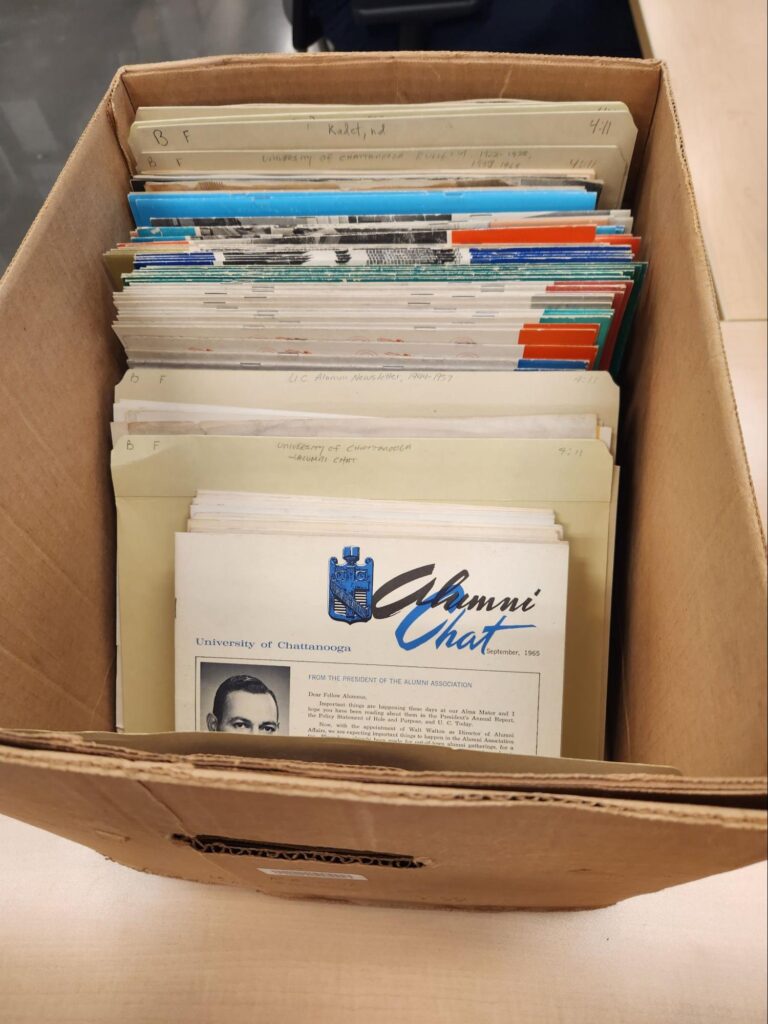This blog post was authored by Nina Richard, an intern in the Library’s Special Collections unit from the Department of English in Spring 2023.
Before I began my internship at the University of Tennessee at Chattanooga’s Special Collections Department, I met with several archivists in the UTC Library asking them questions regarding their careers. I was interested in becoming an archivist and wanted to know more about what the job entailed and the steps I needed to begin taking in order to ensure my success in obtaining the role. I soon learned of the internship position in the Special Collections and was eager to apply and gain some hands-on experience in the field. By the end of 2022, I had been accepted as an intern.
The internship only lasted for one semester, but during this time I was able to gain a plethora of skills in archival work. The first collection I worked on was processing the University of Chattanooga Alumni Association newsletters and magazines. I began this project by authoring basic descriptive metadata for both the collection and for each magazine, including dates, names, and the unique identifier. I then physically rearranged the newsletters and magazines, first separating out the military newsletters from the alumni magazines and then organizing them by year in archival folders.

After processing the collection physically, I could then turn to the digital aspects of processing, which first was to create a Describing Archives: A Content Standard (DACS)-compliant finding aid. I created the Scope and Contents note and the Biographical / Historical note, two very important features found in a finding aid, by conducting research with resources in UTC’s Digital Collections, such as the collections of student newspapers and past course catalogs. I used these to find information regarding the Alumni Association and the Alumni newsletters.
One of the most time-consuming, yet rewarding, aspects of working with this collection was scanning each page of the magazines. Approximately 45 to 50 hours of my internship experience was spent scanning. Though slow-moving, it allowed me the opportunity to spend close time with each page, pouring over the old photographs and articles relating to the life of alumni. My favorite pages to look at were the accolades sections which detailed achievements made by former students at the University of Chattanooga. Through a variety of disciplines, former alumni were making an impact on the world. As this is my final semester at UTC, it brought questions to my mind of the legacy I want to leave behind as a UTC alumna and how I can make an impact in either my own field or in the world around me.

When I finished scanning the final Alumni Association magazine, I quickly moved on to the next project which was to process and digitize the Lookout Mountain Civilian Conservation Corps photographs. Similar to the beginning stages of the project before, I first created basic metadata for the photographs. However, unlike the first project, these metadata fields required more research and creative description than the metadata in the previous collection. Also, each individual photograph needed unique metadata. Each publication in the Alumni Association newsletters and magazines required almost the exact same metadata, whereas each photograph in this collection had individual characteristics that made the metadata creation more complex. For this project I created a description of the photographs, supplied topics (using Library of Congress Subject Headings), and devised a title for each (using the Getty Research Institute Art and Architecture Thesaurus). I finished this project by scanning the material using an outside-crop which added more time to the scanning process. Unlike the project before, I used more of my own judgment and critical-thinking skills in order to determine what the appropriate metadata for each photograph would be. I even chose what photographs I believed would be good candidates for digitization. Using the UTC Special Collections Collection Development Policy, I determined which photographs were most imperative to include in the Digital Collection. This authority boosted my own confidence in my abilities to make creative and important decisions regarding collection processing.

Before I began my internship, I had no experience in archival work. Therefore, I was worried about the workload and if the archivists here would expect me to know aspects of the archives that I had not had any experience with. However, my experience was the exact opposite. With each new skill I was learning, there was always a helping hand to guide me through the new steps and technology needed to perform the task. I was able to take my time with each new task, making sure that I was giving my due diligence to the collection at hand. It might sound a bit cliche, but by engaging with these older materials, I was able to gain an appreciation for just how important archival work is. For past alumni and their children to be able to view their own family in the magazines is extremely satisfying for someone who spent months putting the collection together and making it accessible to those who’d be intrigued in viewing it. Even those who had family in the Lookout Mountain Civilian Conservation Corps may be able to view the work their relatives were able to achieve regarding the forestry of the area. Archivists keep history alive, every piece of it. Each town, city, state, even country has a history that must be preserved and I feel like I have made some progress in making sure that Chattanooga history is alive and well.